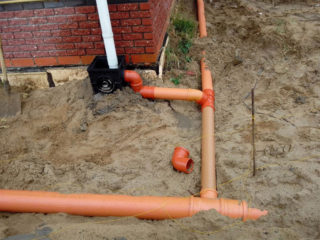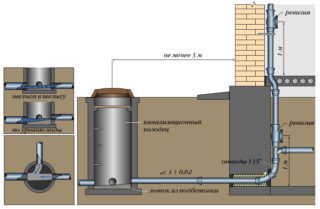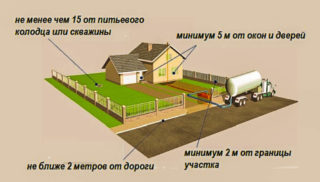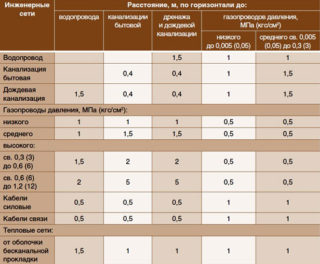In an emergency, sewer pipes can become a source of environmental contamination. With an abundant flow of sewage, there is a risk of disease for people and animals. Wastewater, even with a slight seepage, can destroy the strongest foundation, which will lead to the subsidence of the walls. To avoid this, standards have been developed that regulate the safe distance from the sewer main to the base of the building. They must be taken into account in the construction of sewage treatment lines.
Distance from the foundation to the sewer
Sanitary rules
In SNiPs 2.04.01-85, 2.04.04-84, 2.04.03-85, all specific distances are clearly spelled out. The ratio of sewage devices and the foundation of the building depends on which system is planned for installation: pressure or gravity. In the latter case, the regulations are as follows:
Communication objects | Minimum horizontal clear distance (between the edge of a pipe or well and a wall) in meters | |
| To the foundations of buildings and structures | To fences of industrial facilities, overpasses, overhead and communication supports, railways | |
| Household gravity sewerage | 3 | 1,5 |
| Drainage sewerage | 3 | 1 |
It is necessary to take into account the size of the security zones, which are also necessary for the arrangement of an autonomous sewage system. They depend on the size of the treatment plant and its performance. For example, if the last indicator is 15 cubic meters per day, the sanitary zone will be equal to:
- for the place where underground filters are located - 15 m;
- for a filtration trench or a cushion of sand and gravel - 25 m.
When a treatment plant is constructed from several chambers, a minimum five-meter distance is provided from the foundation to the septic tank, and it is recommended to locate the filter well eight meters from the house.
According to building regulations
SP42.13330.2011 also says that the distance from the base of the house to the network of the pressure sewer system is at least five meters. However, the correspondence between the walls of the pipeline and the sewer well is taken into account here. After all, the networks themselves run along the well center, so the diameter of the well is divided by two and subtracted from the standard distance. So, when a well is cut by two meters, its edge should be located at a distance of four meters from the base wall.
According to SP42.13330.2011, which calculate the standards for gravity sewer systems, the minimum between the foundation and the building, as well as according to SNiPs, is three meters. But here, too, they start from the central passage of the networks. So, with a meter well section, its edge can be located 2.5 meters from the house.
If the communication underground highways are long and winding, have many nodes and additional devices,under highways with heavy traffic or under the entrances to large industrial facilities, the pipeline is laid in prefabricated collector tunnels made of reinforced concrete.
A similar arrangement of sewer pipes allows for repair work without opening the asphalt on the roadway. This makes it much easier to carry out preventive and maintenance activities.
Reducing the distance from the sewer to the foundation

The distance between sewer lines and buildings should allow for repair work, as well as ensure the protection of adjacent highways in an emergency. It is unacceptable that the drains undermine the base of the house and the walls of the wells if the sewer pipes are damaged. But it is especially important that wastewater does not enter the soil and water supply.
Sometimes the territory is so small that it is extremely difficult to comply with all the standards. There is an opportunity to equip the sewage system a little closer to the house, and it is confirmed by two regulatory documents: SP 42.13330.2011 and VSN 61-89 (p). They say that the indicated distances can be reduced in cramped conditions, if it is technologically possible and does not threaten the safety and reliability of the structure.
The sewer main can be laid one and a half meters from the base of the house if it is made of cast-iron pressure pipes in a protective case at a level exceeding the level of the base of the foundation by 0.5 m.
Legal and legal responsibility
First of all, in the event of an emergency or violation of sanitary standards, they will check:
- Heads of design companies. They will be asked if the drawings and diagrams were drawn up incorrectly, calculations were made.
- Construction customers. They are responsible for the readiness for commissioning of the constructed highway. They will check whether they have chosen professionals for its manufacture, whether they have chosen the right equipment.
- Scientists who were asked about climate indicators, soil characteristics, occurrence of underground sources.
- Employees of construction and installation organizations. They are responsible not only for laying the pipeline itself, but also for carrying out a test run of the structure.
When violations are detected, checks are carried out extremely carefully. To avoid trouble, it is easier to comply with the regulations: they are not so strict and involve assumptions while adhering to technical safety requirements.
Not only legal entities, but also individuals can become responsible for the incorrect laying of sewer mains. If a person decides to independently lay pipes on the site, as he pleases, he can also be prosecuted for violating sanitary standards and environmental legislation.
Responsibility is imposed not only if only the normative distances between the foundation and the wall of the house are violated. This indicator should not contradict other rules for placing communications on the site. The coordinated arrangement of communication lines is necessary to protect them from damage in case of accidents and to carry out repair and construction work.











